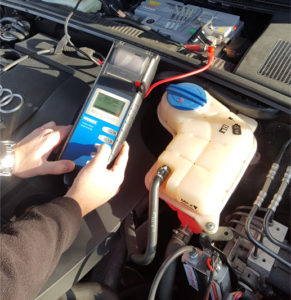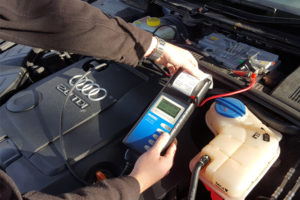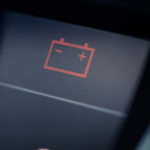Rotronics explores the value of introducing a simple and speedy battery system check that can be built in to every day workshop inspections.
The winter brings with it a lot of fun and excitement, bit it can also be a time when motorists fall foul of the increased risk of roadside breakdowns and battery related non- starts. As a result, independent workshops are inundated with car battery issues.
Cause and effect
The inevitable fall in temperature at this time of year will significantly affect a battery’s performance and, in extreme temperatures, this can mean as much as a 50% dip.
There are increased power demands on a vehicle due to the darker nights; lighting, heating systems, electrics, heated seats and de-misting windows, all together, put an excessive drain on the vehicle’s battery, so charging is vital. In a routine service, the brakes, oil, tyres, exhaust and all fluid levels are checked as standard, but why not the battery? The battery, for some reason, is often overlooked yet it is one of the single most important components of the vehicle.
Many vehicle batteries in use today will be in a discharged or semi-discharged state. The vehicle’s alternator isn’t able to cope with the high demands of the modern consumer requirements, especially when the vehicle is driven on numerous short start/stop journeys. A battery voltage should always be above 12.4V to prevent sulphating of the cells (the most common cause of battery failure) reducing perfomance and serviceable life of a the vehicle’s battery.
Introducing a ‘Test & Charge’ service
Rotronics, the UK partner for CTEK and Midtronics battery management technology, is an industry leader in battery maintenance and service solutions and our team always recommends that independent workshops offer a simple battery ‘Test & Charge’ service for every vehicle that enters their premises. You can then identify all opportunities in supporting your customers and their vehicles with just a few simple steps:
1. Test every vehicle’s battery using a diagnostic battery tester, as part of your winter inspection programme.
2. Notify the customer/owner of the outcome, stating that the battery is: a) Good – fully charged (no action required); b) Faulty – needs replacing (offer replacement).
Offering this service helps you to show your customer how to prevent an issue before they’re standing at the side of the road in the snow or rain. It also presents you with additional revenue streams by giving you the chance to identify a faulty battery and, more importantly, replacing it.
Get with the programme
Rotronics works with independent workshops and fleet customers to deliver simple, effective battery and electrical system testing processes that integrate into every-day workshop practices. Return-on-investment can be demonstrated through both sales and fleet maintenance programmes and each workshop customer is given the expertise and know-how to maximise fault diagnosis and increase productivity and customer service within their own workshop.
The programmes are moulded around each business’ individual requirements and Rotronics’ technology can help to extend the life of a vehicle’s battery, as well as identifying those batteries that are likely to fail during the winter. This enables technicians to accurately diagnose and proactively inform customers of any impending defect or failure before it impacts on their vehicle.
The Rotronics Battery Management Programme keeps a full record of use and allows workshop operators/owners to monitor and track opportunities and upselling potential as part of everyday service and inspection activities carried out by their technicians.
Ken Clark, Managing Director at Rotronics, says: “Battery failures and non- starts create very expensive, time-consuming diversions at this time of year and can make the relationship with customers extremely tense. The majority of the issues faced can be prevented with a little care, maintenance and preparation, however.
“Workshops can be preparing well in advance for the onslaught of the chilly weather and dark nights. The best time to prepare for the next winter’s battery problems is in the winter itself or straight afterwards when all the issues and costs are at the front of your mind.”
Did you know?
Once the batteries are in a good, healthy and charged condition, ensure that the charging system is also performing as it should. You should also:
- Ensure the starter system is working correctly.
- Check the alternator output.
- Ensure there are no excessive drains present, which can cause batteries to go flat very quickly.

STEPS TO SUCCESS
The Battery Management Programme from Rotronics has some simple steps to help you and your workshop team cope with the effects of winter:
Visual inspection
Always check batteries for signs of damage. Look for signs of corrosion, excessive electrolyte staining and gassing. Make sure that the hold down clamps and terminals are secure and free from dirt or corrosion; make sure that the electrolyte levels are maintained.
Test & Charge batteries
Batteries, like any other component on a vehicle, need a little care and attention from time to time. As part of a regular vehicle inspection, you should ensure that:
■ Batteries are charged at every opportunity.
■ Batteries that have been jump- started are tested. A jump-start is only a temporary fix which, in many cases, is hiding an underlying problem.
■ Keep the batteries above 12.5V to prevent excessive deep cycling and risk of sulphation – the root cause of premature battery failure and unnecessary replacement costs.
■ If you’re using non-maintenance free batteries, be mindful when checking the electrolyte levels that if the battery is in a low state of charge, the electrolyte will be lower than expected. If a flat battery is topped up with electrolyte, there is a high risk that the battery will be overfilled and the cells expand as the battery takes current on board.
■ Never top up flat batteries with electrolyte.
■ Always charge first, providing that the cells aren’t exposed.
Vehicle health check
Once the batteries are in a good, healthy and charged condition, ensure that the charging system is also performing as it should.
You should also:
■ Ensure the starter system is working correctly.
■ Check the alternator output.
■ Ensure there are no excessive drains present, which can cause batteries to go flat very quickly.
Rotronics is happy to provide workshops with a free evaluation and demonstration on how you can save time and money, as well as increasing customer service and sales opportunities this winter. Email: info@rotronicsbms.com, visit: www.rotronicsbms.com or call: 0121 526 8185 to find out more.










